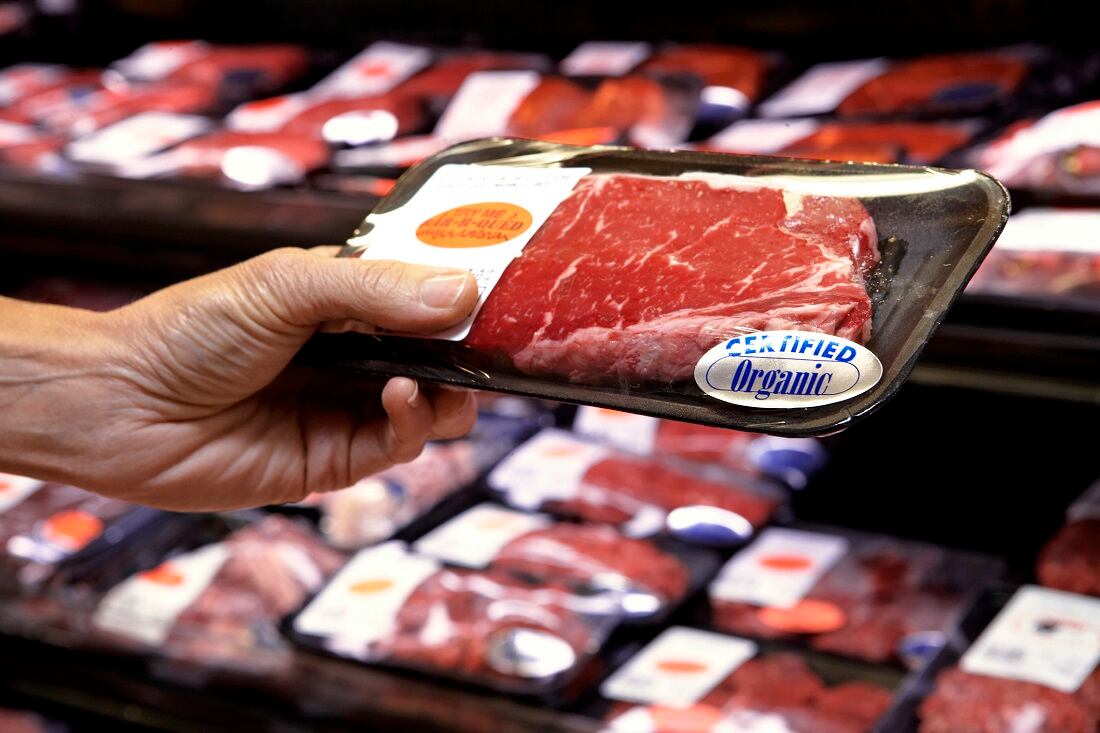While US retail sales of meat in measured channels remained flat between 2021 and 2020, hitting $82.2bn last year, sales on a five-year basis (2016 vs. 2021) were up over 45% driven by at-home eating trends and consumers' desire for variety and a premium experience.
By comparison, plant-based meat alternatives, while growing at a faster rate with sales up 45% between 2019 and 2020, represent 2.7% of retail packaged meat sales hitting $1.4bn in sales, according to the Plant Based Foods Association.
“What this means when someone goes to the store, they’re spending $86.30 in total when meat is in that basket. If you ever doubted that meat is the anchor of the grocery shop, keep in mind that when meat’s not in the basket, they’re spending dozens of dollars less,” noted Parker during IRI’s More than Meats the Eye webinar.
According to IRI data, 98.5% of US households bought meat in 2021 making an average of 50.4 trips annually to buy meat.
“Those are some huge numbers that frankly no other department can claim,” she said.
Assortment and variety: ‘Diversity is meat’s superpower’
“When you think back to 2019, the average American was typically engaging with about 20 cuts or kinds [of meat] in the average year,” noted Parker.
In 2021, the average American consumer purchased 42 different cuts or kinds of meat, and in general compared to pre-pandemic, shoppers are buying more meat more often and in more variety, said Parker.
“In fact, no single cut or kind commands more than a quarter of all dollars spent in the meat department. What’s been interesting though is as we’ve become more diverse in our meat shopping as a society, the most popular and ubiquitous cuts are commanding less dollar share,” said Parker, who noted that consumers are purchasing premium cuts of meat more often.
“When consumers are thinking about treating themselves to a premium experience, they think meat. And they’ve also gotten much more interested in trading up in certain high value, premium, and escapism type activities.”
'We also saw a tremendous amount of exploration'
While common cuts, such as ground beef, pork loin, and chicken breast declined in 2021 vs. 2020 -4.6%, -4.3%, and -1.7% in dollar sales respectively, premium and more exploratory kinds of meat were up in both dollar sales and volumes: beef loin (+4.0% in dollar sales, +8.4% in volume sales), prime (+22.4%, +11.4%), wagyu (+78.8%, +188.2%), beef ribs (+16.7%, +3.4%), lamb (+9.4%, +1.2%), and beef offal (+18.8%, +16.6%).
Organic meat products managed to grow slightly by 3.3% in dollar sales and 2% in volumes, while antibiotic-free grew by 1.3% in dollar sales but declined -4.4% in volume.
“We also saw a tremendous amount of exploration. For example, lamb consistently month to month is growing. This wasn’t just a situation during the early days of the pandemic when maybe we were out of stock of certain high stock items. What changed is Americans are more confident in their cooking skills and more educated than ever,” Parker also pointed out.
'Lamb consistently month to month is growing'
Going hand in hand with Americans' growing confidence in the kitchen and familiarity with premium cuts of meat, is the rise of prepped and convenient cuts of meat. According to IRI, beef ingredient cuts, prepared entrées, chicken ingredient cuts were up both in dollar and volume sales year-over-year with cooking meal kits registering the most growth increasing 37.6% in dollar sales and 32.5% in volume.
“When a prepared entrée or side dish is merchandised adjacent to raw protein in the meat department it’s doing well, double-digit well. The idea that just because things cost more people are going to trade down isn’t necessarily happening if that convenience is top of mind,” said Parker.
The opportunity: Heavy vs. light meat shoppers
According to IRI data, "heavy meat spenders" (i.e. households who spend over $600 in the meat department annually) are more plentiful and driving growth faster than their medium and light spending counterparts. Heavy meat buyers, noted Parker, tend to be Gen X or Boomers who are two times more likely to have children in the household.
"In essence, heavy meat buyers are more important than ever before and more Americans now qualify as heavy spending meat households. For retailers, gaining that heavy meat buyer's loyalty and trust absolutely has a ripple effect across the store," said Parker. "When meat is in the heavy meat buyer's basket it becomes about the meal (e.g. frozen vegetables, potatoes, gravy and sauce mixes)."
While the heavy meat buyer will always seek out meat during their shopping trip, discounting complementary items is an effective way for retailers to attract and maintain their attention and dollars.
"Light meat shoppers," those who spend less than $300 annually on meat and make 14 trips to the store to buy meat, represent double the amount of households (63 millions consumers) compared to heavy meat consumers and thus are a vital opportunity for the meat segment looking ahead, argued Parker.
"They are still increasing their spend of fresh meat, but they're more likely to go with historically perceived leaner cuts like chicken and turkey. They're also dabbling in things like meat alternatives and see seafood as interchangeable with the meat department. They're very much about diversity and excitement in that center of plate," said Parker.
Demographically, light meat eaters represent a more plentiful and younger (under the age of 40) household, added Parker.
"This is the future consumer," added Parker.
'Are meat alternatives stealing share from meat? The answer is no, not really'
"I get asked frequently about meat alternatives and if they're stealing share from meat. The answer is no, not really," said Parker. "Overall there remains some decent growth but it has especially cooled in the latest quarter."
According to IRI, 18.6% of US households bought either frozen or refrigerated meat alternatives last year, noted Parker who added that among those purchasers almost half of US consumers that tried meat alternatives in 2021 did not make a repeat purchase.
"When it comes to meat alternatives, these are meat buyers. Meat alternatives have a place in the meat industry to further engage consumers in new and different ways," said Parker.




